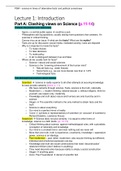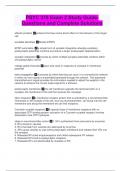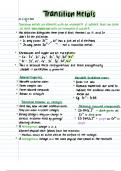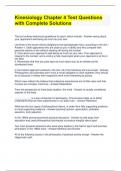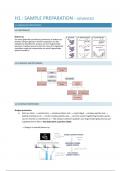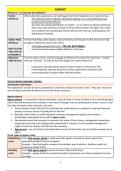Definition/conceptualisation
WEEK 1
Chapter 1: Sampling Distribution
Key Concepts
Sample Statistic A number describing a characteristic of a sample
Sampling Space All possible sample statistic values
Sampling All possible sample values and their probabilities or probability
Distribution densities
Probability A means of getting the probability that a continuous random variable
Density falls within a particular range
Random Variable A variable with values that depend on chance
Expected Value The mean of a probability distribution, such as a sampling distribution
Unbiased A sample statistic for which the expected value equals the population
Estimator value
Statistical Inference
● Offers techniques for making statements about a larger set of observations from data
collected for a smaller set of observations
○ Large set of observations → population
○ Smaller set of observations → sample
● Is about estimation and null hypothesis testing
A Discrete Random Variable
Sample Statistic
● Is called a random variable because the score depends on chance, namely the
chance that a particular sample is drawn
● It is a variable because different samples can have different scores
● The value of a variable may vary from sample to sample
Sampling Distribution
● When we draw very many random samples from a population and collect the
frequencies of all outcome scores in a table or chart
● We observe samples (cases) and measure a sample statistic (what we are looking
at) as the (random) variable → 1 sample= 1 observation
●
,Main Topic Subtopic Sub-subtopic Categories Important point
Definition/conceptualisation
○ The numbers on the horizontal axis constitute the sampling space
○ The left-hand vertical axis shows the number of samples that have been
drawn with a particular value for the sample statistic
○ The right-hand vertical axis gives the proportion of previously drawn samples
with a particular number → can be interpreted as probabilities
● Theoretically, the sampling distribution represents an infinite number of samples
● The sampling distribution, here, is a distribution of sample means but the sampling
distribution itself also has a mean → the expected value or expectation of the
sampling distribution
● Is the crucial link between the sample and the population
○ The sampling distribution is connected to the population because the
population statistic (parameter)
○ It is linked to the sample because it tells us which sample means we will find
with what probabilities
○ We need it to make statements about the population based on our sample →
If the mean of the sampling distribution is equal to the true population value
● Complications:
○ The sample must be random
○ The sample statistic must be an unbiased estimator of the population
○ A sampling distribution looks slightly different if our sample statistic is
continuous → with a continuous sample statistic we use probability density
○ It is impractical as it takes lots of time and effort
Probability and Probability Distribution
● If we change the (absolute) frequencies in the sampling distribution into proportions
(relative frequencies), we obtain → probability distribution
● Probability distribution - a sampling space with a probability for each outcome of the
sample statistic
● Discrete probability - limited number of outcomes are possible
● The probability distribution tells us which outcomes we can expect and the probability
of this particular outcome has of occurring
● We may refer to probabilities as a proportion and as percentage
Unbiased Estimator
● Note that the expected value of the proportion of the sample statistic equals the true
proportion of the population statistic → for this reason: the sample proportion is an
unbiased estimator of the proportion in the population
● Most but not all sample statistics are unbiased estimators of the population statistic
○ Because the population is so much larger than the sample, the population
must contain a greater proportion of the sample statistic than the sample
● In contrast, the proportion in the sample is an unbiased estimator of the population
proportion → which is why we do not use the number of a sample statistic to
generalise from our sample to population
● Sometimes, we have to adjust the way in which we calculate a sample statistic to get
an unbiased estimator
○ For instance, we must calculate the standard deviation and variance in the
sample in a special way to obtain an unbiased estimate of the population
standard deviation and variance
,Main Topic Subtopic Sub-subtopic Categories Important point
Definition/conceptualisation
Representative Sample
● A sample is representative of a population if variables in the sample are distributed in
the same way as in the population
● A random sample is likely to differ from the population due to chance → But we
should expect it to be representative, so we say that it is in principle representative of
the population
A Continuous Random Variable
● A continuous variable is one for which we can always think of a new value in
between two values
Continuous Probabilities
● The probability distribution of the sampling space, that is, of all possible outcomes, is
just (nearly) zeros
● And it will take forever to list all possible outcomes within the sampling space,
because we have an infinite number of possible outcomes
Probability Density
● We must look at a range of values instead of a single value
● We have to display a probability as an area between the horizontal axis and a curve
○ This curve is called a probability density function
○ The vertical axis of a continuous probability distribution is a probability density
● A probability density function can give us the probability of values between two
thresholds
● It can also give us the probability of values up to (and including) a threshold value,
which is known as a left-hand probability, or the probability of values above (and
including) a threshold value, which is called a right-hand probability
● Every probability distribution always adds up to one → we can use them to say how
likely or unlikely we are to draw a sample with the sample statistic value in a
particular range
Important Take Away:
● Values of a sample statistic vary across random samples from the same population
→ But some values are more probable than other values
● The sampling distribution of a sample statistic tells us the probability of drawing a
sample with a particular value of the sample statistic or a particular minimum and/or
maximum value
● If a sample statistic is an unbiased estimator of a parameter, the parameter value
equals the average of the sampling distribution, which is called the expected value or
expectation
● For discrete sample statistics, the sampling distribution tells us the probability of
individual sample outcomes
● For continuous sample statistics, it tells us the probability density, which gives us the
probability of drawing a sample with an outcome that is at least or at most a particular
value, or an outcome that is between two values
, Main Topic Subtopic Sub-subtopic Categories Important point
Definition/conceptualisation
WEEK 2
Chapter 2: Probability Models
Key Concepts
Bootstrapping Sampling with replacement from the original sample to create a
sampling distribution
Exact Approach Calculating the true sampling distribution as the probabilities of
combinations of values on categorical variables
Theoretical Using a theoretical probability distribution as an approximation of the
Approximation sampling distribution
Independent Samples that can in principle be drawn separately
Sample
Dependent/Paired The composition of a sample depends partly or entirely on the
Samples composition of another sample
The Bootstrap Approximation of the Sampling Distribution
● The first way to obtain a sampling distribution is still based on the idea of drawing a
large number of samples
○ However, we only draw one sample from the population for which we collect
data
● As a next step, we draw a large number of samples from our initial sample → The
samples drawn in the second step are called bootstrap samples
● For each bootstrap sample, we calculate the sample statistic of interest and we
collect these as our sampling distribution
● We usually want about 5,000 bootstrap samples for our sampling distribution
● Benefit
○ We can get a sampling distribution for any sample statistic that we are
interested in
● Limitation
○ The original sample that we have drawn from the population must be more or
less representative of the population. The variables of interest in the sample
should be distributed more or less the same as in the population. If this is not
the case, the sampling distribution may give a distorted view of the true
sampling distribution
Sampling With and Without Replacement
● To construct a sampling distribution from bootstrap samples, the bootstrap samples
must be exactly as large as the original sample
● If we allow every case in the original sample to be sampled only once, each
bootstrap sample contains all cases of the original sample, so it is an exact copy of
the original sample → Thus, we cannot create different bootstrap samples
○ Sampling without replacement- If a person is (randomly) chosen for our
sample, we do not put this person back into the population so she or he can
be chosen again

